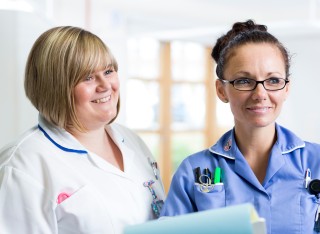
Amy Dopson
Academic and research departments
School of Health Sciences, Faculty of Health and Medical Sciences.About
Biography
As one of two Heads of Department – Education, Amy oversees all Continuing Professional Development and Post Graduate Taught Programmes within the School of Health Sciences. Now a member of the Senior Management Team, Amy has been a member of academic staff within the school for the past 14 yrs, having previously held the roles of Field Lead for the Child Nursing BSc Programme then Director of Studies – Nursing. Amy is a duel qualified nurse with a clinical background of over 30 years healthcare experience, specialising in Emergency Care. As an Advanced Paediatric Nurse Practitioner working across a number of central London and home county NHS organisations, the role of the Advanced Clinical Practitioner and Children's Emergency Care are areas she remains passionate about.
Driven by a strong commitment to professionalism and excellence in healthcare practice, Amy is keen to ensure the school leads nationally, providing innovative healthcare programmes that inspire and motivate our professional preparation students to question and develop practice. Having recently moved to focus on CPD & PGT programmes, Amy now aids to support the development of a portfolio of programmes that support and excite colleagues with lifelong learning.
With a keen interest in supporting excellence in student experience Amy holds a university wide role, supporting the Office of Student Complaints, Appeals and Regulations, as Chair for a number of university panels; Fitness to Practice, Support to Study, Disciplinary and Appeal panels. In addition she is an NMC visitor, supporting national programme validations and reviews and External Examiner at Sheffield Hallam University.
Having initially trained as a Registered General Nurse at The Nightingale Institute, Guys Hospital, Amy then completed her Children's Nursing programme here at Surrey, her MSc in Advanced Practice at City University, and commenced her PhD studies within the school.
Teaching
Main areas of interest:
- Education in Healthcare
- Professionalism, professional development and identity.
- Development of clinical practice in healthcare - in particular the use of simulation
- Confidence in assessment of the Unwell/Deteriorating Child
- Paediatric Emergency Care
- Advanced Assessment
- Safeguarding Children
- Ethics in healthcare
University roles and responsibilities
- Head of Department: CPD & PG taught Education (School of Health Sciences)
- Chair OSCAR Regulatory Panels (University Wide)
- Chair Staff Development Committee (School of Health Sciences)
- Module Leader (Various Modules)
News
In the media
ResearchResearch interests
Parents experiences of witnessing invasive treatment (MSc)
Teaching ethics in nursing: combining forum theatre and simulation
Decision-making processes of parents accessing urgent healthcare services (PhD)
Prevention of injury in children
Research interests
Parents experiences of witnessing invasive treatment (MSc)
Teaching ethics in nursing: combining forum theatre and simulation
Decision-making processes of parents accessing urgent healthcare services (PhD)
Prevention of injury in children
Teaching
Main areas of interest:
- Education in Healthcare
- Professionalism, professional development and identity.
- Development of clinical practice in healthcare - in particular the use of simulation
- Confidence in assessment of the Unwell/Deteriorating Child
- Paediatric Emergency Care
- Advanced Assessment
- Safeguarding Children
- Ethics in healthcare
Publications
Highlights
Conference presentations
“Exploring Ethical Issues Through Performance Simulation – A Collaboration between Performance and Practice”
Panel on Nursing Education, 1-4 May 2017, Athens, Greece as part of the 3rd Annual International Conference on Nursing. Athens Institute for Education and Research (ATINER)
“Facilitating Students’ Confidence in Dealing With Challenging Situations in Practice”
3rd Nursing World Conference (NWC), Rome 2018
Published work
Jones F, Whitehouse A, Dopson A, Palaghias N, Aldiss S, Gibson F, Shawe J (2019) Reducing unintentional injuries in under-fives: Development and testing of a mobile phone app, Child Care Health Development, 1-10. DOI: 10.1111/cch.12729
Dopson A, Colliety P., Andrews S., Hughes T & Markless S., (2017) “Terrifying but Amazing”: The Use of Supported Performance Simulation to Enhance Student Nurseʼs Ability to Learn and Articulate Ethically Sound Practice, Athens Journal of Health, 5(1): 37
Action Research Project, evaluating cross-faculty learning and teaching project to enhance ethical understanding and practice for student nurses
Dopson, A., Colliety, P., Andrews, S., Hughes, T. and Markless, S. (2017). “"Terrifying but Amazing": The Use of Supported Performance Simulation to Enhance Student Nurseʼs Ability to Learn and Articulate Ethically Sound Practice”, Athens: ATINER'S Conference Paper Series, No: NUR2017-2260.
[Paper above, initially published as conference paper]
Dawson P, Cook L, Holliday L & Reddy H Eds. (2012) Clinical Skills in Children’s and Young People’s Nursing. Oxford University Press, Oxford
Contributed following six sections:
- Cardio vascular system: History taking and assessment
- Cardio vascular system: Cardiac monitoring
- Cardio vascular system: 12 lead ECG
- Cardio vascular system: Positioning of electrodes
- ENT System: Removal of foreign body from nose
- ENT System: Removal of foreign body from ear
Currently revising for 2nd Edition due out 2020
Glasper EA, McEwing G, Richardson J Eds. (2011) Emergencies in Children and Young People’s Nursing Oxford University Press, Oxford.
Contributed following four sections:
- Sudden Unexplained Death in Infancy
- Witnessed Resuscitation
- Unexpected Death
Dopson A (2008) Competence and Confidence in Paediatric Drug Calculations Nurse Prescribing 6(5)
- Clinical article aimed at supporting qualified nurses with drug calculation competency.
Dopson A (2001) Penetrating Trauma: a case of the unexpected Emergency Nurse 9(1) 36-40
- Clinical article discussing the implications and consequence, through a case study, of the downsizing of Accident and Emergency departments.
Removal of foreign body from nose vii.ENT System: Removal of foreign body from ear
Background: Unintentional injuries are a leading cause of preventable death and a major cause of ill health and disability in children under five years of age. A health promotion mobile phone application, ‘Grow up Safely’, was developed to support parents and carers in reducing unintentional injuries in this population of children. Methods: A prototype of the mobile application was developed to deliver health education on unintentional injury prevention linked to stages of child development. In order to explore the usability of the app and refine its content, three focus groups were conducted with 15 mothers. Data were analysed using thematic analysis. Results: The majority of participants reported previous use of health apps, mainly related to pregnancy, and recommended by health professionals. The app was considered user‐friendly and easy to navigate. Participants in two focus groups found the app informative, offered new information and they would consider using it. Participants in the ‘young mum's’ group considered the advice to be ‘common sense’, but found the language too complex. All participants commented that further development of push‐out notifications and endorsement by a reputable source would increase their engagement with the app. Conclusion: The ‘Grow Up Safely’ mobile phone app, aimed at reducing unintentional injuries in children under five, was supported by mothers as a health promotion app. They would consider downloading it, particularly if recommended by a health professional or endorsed by a reputable organisation. Further development is planned with push‐out notifications and wider feasibility testing to engage targeted groups, such as young mothers, fathers and other carers.

